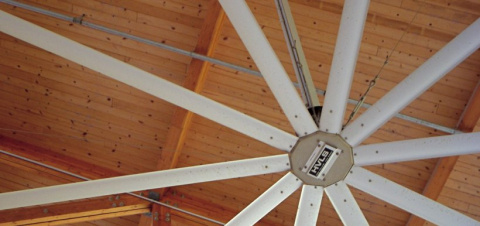Ventilation is the least expensive and most energy-efficient way to cool buildings. It works best when combined with methods to avoid heat buildup in your home. In some cases, natural ventilation will suffice for cooling, but it often needs to be supplemented with spot ventilation, ceiling fans, and window fans. For certain homes, homeowners might want to investigate whole house fans.
Effective Ventilation Strategies
- Utilize cool breezes and natural convection in parts of the United States where this is sufficient.
- Ideal for homes with significant temperature swings between day and night.
- Use spot ventilation, such as bathroom and kitchen exhaust fans, to remove heat and humidity generated inside your home.
- Minimize indoor heat generation by using microwave ovens or outdoor grilling instead of stovetops and ovens.
Ceiling Fans, Window Fans, and Other Circulating Fans
- Ceiling fans and window fans can improve your comfort level by circulating air within your home.
- Newer technology ceiling fans with DC motors use significantly less energy than conventional fans.
- Ideal for larger homes in moderate or dry weather.
- Open numerous windows to achieve lower indoor temperatures through excellent ventilation.
- Homes with duct systems can use those ducts to supply ventilation air throughout the home.
Managing Heat Buildup
- Shading and Insulation:
- Landscape your lot to provide shade to your house.
- Use light-colored and more reflective roofing materials to reflect heat.
- Insulate your house to at least code-recommended levels and consider installing a radiant barrier along the roofline if the attic is vented.
- Sealing and Windows:
- Close all windows and exterior doors on hot days when outdoor temperatures are higher than indoor temperatures.
- Install window shades or other treatments to block direct sunlight and radiated heat from outside.
- Use insulated shades to reduce heat conduction through windows.
- Reducing Indoor Heat Sources:
- Avoid using the oven and opt for microwave cooking or outdoor grilling.
- Use spot ventilation in the kitchen and bathroom to remove heat and humidity.
- Ensure your laundry room is well-ventilated, and always vent electric and gas dryers to the outside.
- Avoid activities that generate heat, such as burning open flames, running the dishwasher, and using hot devices like curling irons or hair dryers.
- Attic Ventilation:
- Passive attic ventilation and radiant barriers can help reduce the need for air conditioning in hot, humid climates.
- Consider sealing the attic and making it part of the conditioned space in your house by placing insulation on the underside of the roof.
Effective ventilation, combined with strategic heat management, can significantly enhance your home's comfort while saving energy and reducing costs. By leveraging natural ventilation, spot ventilation, ceiling and window fans, and whole house fans, you can create a cooler, more energy-efficient living environment.
Take Action
For more expert tips and detailed information on cooling your home efficiently, visit our Energy Saver 101 infographic on home cooling. Start implementing these strategies today to enjoy a cooler home and lower energy bills.
Subscribe to receive updates from Energy Saver, including new blogs, updated content, and seasonal energy saving tips for consumers and homeowners.


